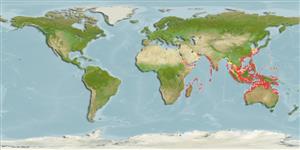Classification / Names
Common names from other countries
Main reference
Size / Weight / Age
Max length : 80.0 cm TL male/unsexed; (Ref. 5213); common length : 50.0 cm TL male/unsexed; (Ref. 30573)
Length at first maturity
Lm ?, range 35 - ? cm
Environment
Marine; brackish; reef-associated; depth range ? - 75 m (Ref. 2799)
Climate / Range
Tropical, preferred 27°C (Ref. 107945); 32°N - 32°S, 18°E - 154°E
Distribution
Indo-West Pacific: Red Sea and east coast of Africa to southeast Asia, north to Taiwan, south to Queensland, Australia. Also reported from Persian Gulf (Ref. 68964).
Countries | FAO areas | Ecosystems | Occurrences | Introductions
Short description
Dorsal
spines
(total): 12;
Dorsal
soft rays
(total): 13-15;
Anal
spines: 3;
Anal
soft rays: 7 - 8. Body is slender; the head profile slightly convex; lips not thickened; 2 pores and a central groove under the chin. No antrorse spine before the dorsal fin origin; a deep notch between the spinous and the soft-rayed portion of the dorsal fin. Color is generally silvery with a golden tint on the sides; the upper operculum olive-yellow; the snout dusky, overlain with yellow. Young specimens have 7-11 vertical bands on the upper sides; older ones with bands formed by spots aligned in vertical rows.
IUCN Red List Status (Ref. 115185)
Threat to humans
Harmless
Human uses
Fisheries: commercial; aquaculture: commercial; gamefish: yes
More information
ReferencesAquacultureAquaculture profileStrainsGeneticsAllele frequenciesHeritabilityDiseasesProcessingMass conversion
Tools
Special reports
Download XML
Internet sources
Estimates of some properties based on models
Phylogenetic diversity index
PD50 = 0.5000 many relatives (e.g. carps) 0.5 - 2.0 few relatives (e.g. lungfishes)
Trophic Level
3.5 ±0.51 se; Based on food items.
Resilience
Medium, minimum population doubling time 1.4 - 4.4 years (K=0.25-0.57)
Vulnerability
Moderate vulnerability (38 of 100)
Price category
